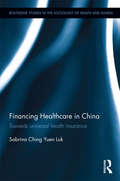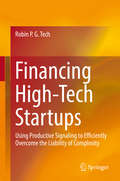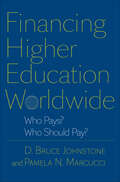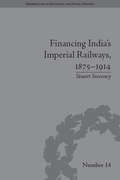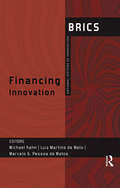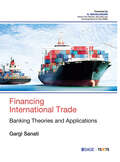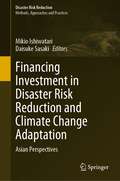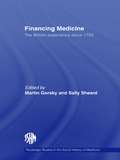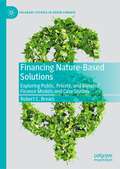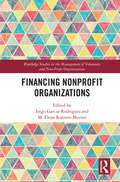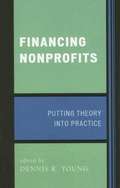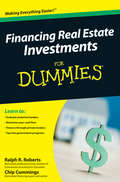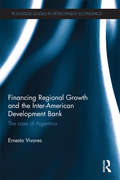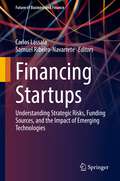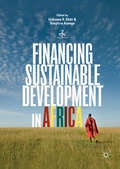- Table View
- List View
Financing Healthcare in China: Towards universal health insurance
by Sabrina Ching LukChina’s current social medical insurance system has nominally covered more than 95 per cent of 1.4 billion population in China and is moving towards the ambitious goal of universal health insurance coverage. Challenges posed by a rapidly ageing population, an inherently discriminatory design of the health insurance system, the disorder of drug distribution system and an immature legal system constrain the Chinese government from realizing its goal of universal health insurance coverage in the long run. This book uses a refined version of historical institutionalism to critically examine China's pathway to universal health insurance coverage since the mid-1980s. It pays crucial attention to the processes of transforming China's healthcare financing system into the basic social medical insurance system alongside rapid socio-economic changes. Financing Healthcare in China will interest researchers and government and think-tank officials interested in the state of healthcare reforms in China. Healthcare specialists outside of East Asia may also be interested in its general study of healthcare in developing countries. Scholars and students interested in the healthcare field will also find this useful.
Financing High-Tech Startups: Using Productive Signaling To Efficiently Overcome The Liability Of Complexity
by Robin P. TechThis book examines the adverse effects of complexity, information asymmetries, transaction costs, and uncertainty on investors’ decision making. It suggests mitigating those effects using appropriate and matching signals, and analyzes a sample of 903 German startups to quantitatively highlight the distinct financing patterns and characteristics of high-tech startups. It then investigates the reasons for these patterns on the basis of a qualitative study that includes 34 interviews with investors and entrepreneurs in the US and Germany and an international expert panel. Lastly, it presents a framework that matches complexity factors with appropriate productive signals.
Financing Higher Education Worldwide: Who Pays? Who Should Pay?
by D. Bruce Johnstone Pamela N. MarcucciNo issue in higher education is as salient, or as controversial, as finance. As demand for higher education around the world grows, so do the costs associated with it, especially as governments shoulder less of the burden. Tuition fees rise and student loan debt grows. Who pays for these surging costs? Who should pay? D. Bruce Johnstone and Pamela N. Marcucci examine the universal phenomenon of cost-sharing in higher education—where financial responsibility shifts from governments and taxpayers to students and families. They find that growing costs for education far outpace public revenue streams that once supported it. Even with financial aid and scholarships defraying some of these costs, students are responsible for a greater share of the cost of higher education.Featuring comprehensive economic and policy data, the authors' international comparative approach shows how economically diverse countries all face similar cost-sharing challenges. So, who should pay for higher education? While cost-sharing is both politically and ideologically debated, Johnstone and Marcucci contend that, for almost all countries, it is imperative for the financial health of colleges and universities, bringing better efficiency, equity, and responsiveness. Financing Higher Education Worldwide combines sophisticated economic explanations with sensitive political and cultural analyses of the financial pressures facing higher education throughout the world.
Financing Higher Education in Africa
by World BankThe training and development of human capital in Sub-Saharan Africa (SSA) will help countries in the region diversify their economies, carry out economic transformation, and support sustainable growth. Higher education plays a key role in training qualified individuals who will be able to implement new technologies and use innovative methods to establish cost-efficient and effective enterprises and institutions. However, in order for SSA to reap the benefits of this investment in human capital, higher education institutions must secure financing to provide quality training and sound professional prospects to their students. Currently, tertiary education development is unsustainable-resources per student are declining and the quality of education is affected. These issues are particularly pressing in times of financial global crisis, when available resources for tertiary education tend to diminish. The impact of the crisis that started in 2008 provides a clear illustration of the need to explore innovative ways to diversify and secure financing for higher education in SSA. 'Financing Higher Education in Africa' provides a comprehensive overview of higher education financing in SSA. The book begins with an explanation of the fundamental problems faced by higher education institutions and students in SSA, namely the combined pressure of a rapid growth in demand and a growing scarcity of public resources, and it presents the dramatic consequences of these trends on quality. The book then turns to analyzing and comparing the current funding policies in SSA countries and it provides recommendations for improvement. Finally, the book examines the alternatives to the status quo and the policy tools needed to both diversify resources and allocate them based on performance. It will be of great interest to governments, universities, research institutions, and international organizations throughout the region.
Financing Higher Education: Answers from the UK
by Nicholas Barr Iain CrawfordThis topical volume tells the story of the UK debate on financing higher education, illustrating a head-on collision between the economic imperatives of student loans and regulated market forces, and the political imperative of 'free' higher education. In telling the story of the partnership of an economist and a political professional, the book offers lessons about both policy design and the politics of reform: of particular relevance to countries which have not yet addressed the issue, including many OECD countries, the more advanced post-communist reforming countries and, increasingly, to middle-income developing countries. No longer the exclusive province of a small intellectual elite, higher education is a key element in national economic performance. A modern economy needs a high-quality university system, and needs to make it accessible to everyone who can benefit, but mass higher education is expensive, and competes for public funds with pensions and health care, to say nothing of nursery education and schools. How to pay for higher education has thus become a central issue, and Barr and Crawford’s book expertly covers the debates and issues involved.
Financing India's Imperial Railways, 1875–1914 (Perspectives in Economic and Social History #14)
by Stuart SweeneyThe Indian railway network began as a liberal experiment to promote trade and commerce, the distribution of food and military mobility. Sweeney's study focuses on Britain's largest overseas investment project during the nineteenth century, offering a new perspective on the Anglo-Indian experience.
Financing Innovation: BRICS National Systems of Innovation
by Michael Kahn; Luiz Martins de Melo; Marcelo G. Pessoa de MatosThis series of books brings together results of an extensive research programme on aspects of the national systems of innovation in the five BRICS countries – Brazil, Russia, India, China, and South Africa. It provides a comprehensive and comparative examination of the challenges and opportunities faced by these dynamic and emerging economies. In discussing the impact of innovation with respect to economic, geopolitical, socio-cultural, institutional, and technological systems, it reveals the possibilities of new development paradigms for equitable and sustainable growth.This volume analyses the financing of science, technology and innovation in the BRICS economies. It highlights the importance of institutional coordination and the influence of implicit policies on the extent to which capital markets may contribute to innovation financing. It stresses the role of state development banks and similar organisations in promoting high-risk and long-run building of innovative capacities with respect to development strategy. Original and detailed data, together with expert analyses on wide-ranging issues, make this book an invaluable resource for researchers and scholars in economics, development studies and political science, in addition to policy-makers and development practitioners interested in the BRICS countries.
Financing International Trade: Banking Theories and Applications
by Gargi SanatiThis first-of-its-kind textbook presents an overview of the fundamental nature and regulatory structure of forex transactions operating within the Indian banking system. Though international trade theory is well discussed in academic circles, trade finance is often viewed as the prerogative of bankers, financers and professionals. However, with the increase in cross-border expansion of trade, financial aspects of international trade has turned out to be one of the key components of various educational programs, at both undergraduate and post-graduate levels. This textbook discusses different types of forex transactions, the regulatory framework within which they take place and the associated risks and solutions. It tries to resolve the existing disparity in the understanding and interpretation of regulatory guidelines and the practices adopted by banks and corporates in implementing them. The cases and examples, integrated throughout the chapters, are coupled with resolutions to the problems discussed and substantial explanation of the underlying principles. Key Features • Caselets and problem definitions weaved throughout the chapters to aid understanding of forex in different realms • Discussion on the roles of institutions other than banks and corporate houses such as RBI, FEDAI, ECGC and DGFT in international trade finance • Ideal companion for students of international finance, international banking, forex business and trade finance, financial markets and others
Financing Investment in Disaster Risk Reduction and Climate Change Adaptation: Asian Perspectives (Disaster Risk Reduction)
by Mikio Ishiwatari Daisuke SasakiAs the population is growing and urbanization is progressing, higher numbers of people are exposed to disaster risks, especially in the developing countries. Climate change is further worsening the impacts of existing risks and introducing new ones. It is imperative that countries need to invest more in disaster risk reduction (DRR) as well as climate change adaptation (CCA) not only to minimize their impacts but also to build resilience.To date, various international arenas have recommended increasing investment in DRR. The Sendai Framework for DRR, adopted by the UN member states in 2015 during the Third UN World Conference on DRR, emphasizes investment as a priority for decreasing disaster risks and losses. The Yangon Declaration set the goal of doubling investment to address water-related disasters. However, most countries are not able to proactively invest enough in DRR. Understanding the current scale and estimate of investment and its effects is crucial for promoting DRR investment, but such information and estimates are rarely available.This book examines the current investment trends and issues in DRR and CCA. Based on specific case studies, field data and evidence, the book identifies challenges in increasing investment and recommends various investment policies and innovative approaches to sustainable progress towards a resilient future.Chapter 12 is available open access under a Creative Commons Attribution 4.0 International License via link.springer.com.
Financing Life Science Innovation
by Alexander StyhreThe life sciences are widely treated as a field and an industry with high-growth potential, and while neoclassical economic theory prescribes that capital are invested in emerging industries, there is a perceived shortage of venture capital among life science entrepreneurs. Financing Life Science Innovation reviews the literature on venture capital, corporate governance, and life science venturing and presents a study of the Swedish life science industry and the venture capital investors being active in financially and managerially supporting life science start-up firms. The study reveals that venture capital investors, life science entrepreneurs, and innovation system actors today face the challenge of supplying adequate amounts of capital to an industry that may produce tomorrow's health care innovations. Changes in scientific research practices, the structure of the international finance market, and industry policy are all contributing to what is frequently treated as a shortage of venture capital in the life sciences.
Financing Medicine: The British Experience Since 1750 (Routledge Studies in the Social History of Medicine #Vol. 24)
by Martin Gorsky Sally SheardFinancing Medicine brings together a collection of essays dealing with the financing of medical care in Britain since the mid-eighteenth century, with a view to addressing two major issues: Why did the funding of the British health system develop in the way it did? What were the ramifications of these arrangements for the nature and extent of health care before the NHS? The book also goes on to explore the 'lessons' and legacies of the past which bear upon developments under the NHS. The contributors to this volume provide a sustained and detailed examination of the model of health care which preceded the NHS - an organization whose distinctive features hold such fascination for the scholars of health systems - and their insights illuminate current debates on the future of the NHS. For students and scholars of the history of medicine, this will prove essential reading.
Financing Nature-Based Solutions: Exploring Public, Private, and Blended Finance Models and Case Studies (Palgrave Studies in Impact Finance)
by Robert C. BrearsThis book presents new research on innovative financial instruments and approaches available to implement nature-based solutions (NBS) at various scales and in different contexts. Despite knowledge of the multiple benefits NBS provide, a key barrier to their wide-spread adoption is a lack of knowledge over their financing, in particular, who should pay for an NBS and how it can be financed. The book explores a variety of public, private, and blended finance models and their applicability in developing NBS across terrestrial and marine ecosystems, involving multiple stakeholders, and in jurisdictions of varying climates and income levels. Furthermore, the book provides case studies of the innovative financing of NBS with best practices identified. This book is of interest to environmental planners, resource conservation managers, policymakers, international companies and organizations, environmental NGOs, researchers, and graduate and undergraduate students interested in NBS.
Financing New Ventures
by Ramana Nanda William R. KerrAid in understanding of financing entrepreneurship.
Financing Nonprofit Organizations (Routledge Studies in the Management of Voluntary and Non-Profit Organizations)
by Inigo Garcia-Rodriguez M. Elena Romero-MerinoThe financial issues of nonprofit organizations (NPOs) have increased their importance in recent years, especially after the last global economic downturn. In this way, NPOs have been threatened by a reduction of income, while their work and expenses have not decreased. In this book, the editors bring together several topics that the academic literature has previously addressed, connecting them to each other and evaluating how all these issues are interrelated. Financing Nonprofit Organizations analyses the state of art of all these financial topics and the consequences of the last economic crisis. It dives into the interrelations of these concepts to suggest lines of future research and to reflect on the future of the different sources of funding of the NPOs. It will be of interest to students, practitioners, and researchers interested in initiating and updating their knowledge in the growing field of the financial aspects of the NPOs.
Financing Nonprofits: Putting Theory into Practice
by Dennis R. YoungEleven American academics contribute 15 chapters examining which combinations of income best support the performance of a nonprofit organization seeking to address a given social mission in a particular set of circumstances. Coverage includes distinct sources of income that can support nonprofit operations--individual giving, institutional philanthropy, government funding, fee income and commercial ventures, membership income, investment income, and volunteer resources--and the circumstances under which each is appropriate; sources of capital for nonprofit organizational development and programming, including collaboration and barter, gifts-in-kind and other illiquid assets, and borrowing and debt; and overall portfolio and performance issues such as managing endowment and other assets, income portfolios, and measuring financial health and vulnerability. Annotation ©2007 Book News, Inc. , Portland, OR (booknews. com)
Financing Operations and Growth: Funding the Different Stages of Growth
by Harvard Business School PressCompanies that are experiencing growth face the challenge of finding the financing to support it. This chapter describes various combinations of internally generated funds and external financing. Using eBay as a case study, the chapter examines these methods of financing growth through different phases in the life cycle of business enterprises.
Financing Our Foodshed: Growing Local Food with Slow Money
by Carol Peppe Hewitt“[Hewitt] paints an engaging portrait of a community learning how to take care of its own, and offers inspiration for others looking to do the same.” —Amy Cortese, author of LocavestingIn towns and cities across North America, a quiet revolution is underway. Fed up with sending their money off to make a fast buck in faraway markets, people are putting their money to work where they live, in markets they trust and understand—starting with food.Financing Our Foodshed is a collection of real-life stories of these Slow Money pioneers and the local food entrepreneurs—sustainable farmers, bakers, restaurateurs, and more—they have chosen to support.Fueled by their desire to do more than just eat local food, lenders of “nurture capital” are making low-interest, peer-to-peer loans to the people who produce, process, distribute and sell local food. Meet these passionate food entrepreneurs like:Abi, talented artist-turned-baker, who borrowed the funds to start a gluten-free bakeryAngelina, owner of a Greek local foods restaurant, who refinanced exorbitant credit card debt incurred by renovationsChatham Marketplace, a much-loved grocery co-op whose monthly loan payments were reduced by a third, thanks to an ambitious collaboration between 16 investorsFinancing Our Foodshed tells the compelling stories of ordinary people doing something extraordinary, and will appeal to anyone who understands the critical importance of sustainably grown local food and resilient local economies, and wants a blueprint to get us there.“For anyone seriously interested in boosting his or her community’s economy—including politicians, policymakers, financiers, businesspeople, and activists—this book is essential reading.” —Michael H. Shuman, author of Put Your Money Where Your Life Is
Financing Our Future: Unveiling a Parallel Digital Currency System to Fund the SDGs and the Common Good
by Stefan BrunnhuberThe monetary system is the indispensable missing link in the debate of sustainability, and whether the current financial system can handle these evolved needs. To date, the UN Sustainable Development Goals (SDGs) primarily have been financed either through the private sector, through conventional public sector taxes and fees, or through philanthropic commitment. Assuming a need of 4 to 5 trillion dollars annually in the 10 to 15 years left to finance our future, these conventional sources of finance are insufficient in terms of both the scale and speed of funding required to finance our future. Furthermore, the inherent instability of our financial system forces the world community to focus first and foremost on repairing and stabilizing the existing system. The development of cryptocurrencies using distributed ledger technologies (mainly blockchain) has prompted leading central banks to study the potential application of this approach to independently create purchasing power. In this vein, this book offers a new approach, namely introducing a parallel electronic currency specifically designed to finance global common goods and provide the resources necessary to achieve the SDGs. Furthermore, this mechanism would have a stabilizing effect on the existing monetary system. The book argues that one way this could be achieved is by giving central banks a modified monetary mandate to inject new liquidity into the system using a top-down approach. Alternatively, liquidity could come from corporate or communal initiatives with crypto- or communal currencies in a bottom-up approach. The author maintains that by issuing a blockchain-enabled parallel electronic currency earmarked for SDG-related projects and using other channels for monetary flow rather than the conventional ones, the future could be financed in a different manner. In the long run, abandoning our current monetary monoculture and introducing a monetary ecosystem would stabilize international financial markets, increase monetary regulatory efforts, reduce negative externalities, create a social Pareto optimum and stabilize democracies. This book presents, in the same spirit as Fritjof Capra’s The Tao of Physics, a Tao of finance—an outside-of-the-box approach to financing global common goods.
Financing PPL Corp.'s Growth Strategy
by Benjamin C. Esty Carrie FermanPPL Corp., an electric utility in Pennsylvania, needs to finance $1 billion of peaking plants as part of its new growth strategy. In February 2001, Steve May, director of finance for PPL's Global Division, is responsible for recommending a finance plan. After considering all the options, May decides that a synthetic lease is the best option, but he must decide whether to recommend a traditional or a limited recourse synthetic lease and how to structure the specific terms. The limited synthetic lease, in contrast to the traditional structure, requires a smaller corporate guarantee on the assets and has greater off-credit treatment, which is important given the company's growth strategy and limited debt capacity. However, finding investors willing to accept greater project risk will cost more and take more time. Timing is an issue for May because if he doesn't close the financing within the next two months, PPL will lose a valuable option to buy turbines for its peaking plants. Failure to exercise the option could delay the company's construction schedule, something PPL wants to avoid given the nationwide race to build new generating plants.
Financing Real Estate Investments For Dummies
by Joe Kraynak Ralph R. Roberts Chip CummingsYour practical guide to scoring cash to fuel your real estate investments Want to be a smart, successful real estate investor? This no-nonsense guide contains everything you must know to make the right choices about financing your investments - from the various options available and the impact on cash flow to the tax implications and risk factors involved. You also get tried-and-true tips for surviving a down market and using current investments to finance future ones. A crash course in real estate financing - understand standard terms and concepts, learn the various sources of investment capital, and gather all essential facts and figures Weigh your options - decide which type of financing is best for your circumstances and incorporate it into your real estate investing plan Finance residential properties - evaluate residential loan programs, navigate the loan application and processing, and handle the closing Invest in commercial properties - know the different property types, choose the one that meets your investment goals, and discover unique sources for financing Tap into unconventional sources - discover the pros and cons of "hard money," capitalize on seller financing, partner to share risk and equity, and invest on the cheap with no-money-down deals Open the book and find: Real-world advice on financing without tying up all your capital How to get prequalified or preapproved for a loan Questions to ask your lender upfront Ways to avoid common beginner blunders How to protect your personal assets from investment risks Bargain-hunting hints for low-cost loans Strategies for surviving a credit crunch Ten pre-closing steps you must take
Financing Regional Growth and the Inter-American Development Bank: The Case of Argentina (Routledge Studies in Development Economics #101)
by Ernesto VivaresThe crisis of the current global financial order is challenging us to critically reflect on how this order has been driven, and the development outcomes produced by its central political and economic actors. There is a great deal of academic knowledge about the role of the international financial institutions, powerful states and capital markets in international development, but there is little understanding of how regional dynamics and regional institutions influence global governance and developing countries. This book offers an independent and grounded investigation concerning the political economic role of Regional Development Banks through a study of the world’s leading regional development bank, the Inter-American Development Bank (IDB). The book examines the political economy of the IDB and its role in regional and national development during the neoliberalisation processes of the 1990s. In particular, the investigations explore the IDB’s power in regional and national development – via its technical, political and financial interventions – to frame policy alternatives, absorb opposition forces, support specific coalition forces and justify a particular direction of development, all in order to legitimize specific political economic projects directed by market-led pro-reform coalitions aligned with global financial forces and financial development guidelines. This book will be relevant to scholars and professionals interested in the international and regional political economy of development financing.
Financing Residential Real Estate (15th edition)
by Megan Dorsey David RockwellFinancing Residential Real Estate has earned a reputation in the real estate community as the most up-to-date, comprehensive, and clearly written book in its field.
Financing Startups: Understanding Strategic Risks, Funding Sources, and the Impact of Emerging Technologies (Future of Business and Finance)
by Carlos Lassala Samuel Ribeiro-NavarreteThere is no doubt that the proliferation of entrepreneurial activity is a current trend. Start-ups enable an effective transformation of knowledge, generating high added value to society. The objective of this book is to address the financing of the entrepreneurial process as a necessary element to articulate a solid business fabric, based on taking advantage of new opportunities. The book is structured in two parts. The first part takes as a reference the lack of financing in the entrepreneurship process and analyses different sources of financing available to entrepreneurs depending on the phase in which the project is located. The second part of the book analyses innovation and its links to the financing of start-ups, addressing the impact of emerging technologies and fintech services and the support of artificial intelligence. Finally, the book concludes with an examination of decentralized finance (DeFi), as an idea that is changing the financial world, giving rise to new financial paradigms.
Financing Sustainable Development in Africa
by Uchenna R. Efobi Simplice AsonguThis edited volume provides a critical evaluation of financing options for sustainable development in Africa. While sustainability has long been the watchword for development programs, and while many African countries have taken initiatives to develop integrated frameworks that tackle developmental challenges—including poverty, education, and health—financing has remained a challenge. In this book, an expert team of chapter authors examines new financing options while also exploring how traditional financing means, such as foreign aid and foreign direct investment, can be more effective for sustainability. The authors discuss how African nations can build adequate structures and productive capacity to create a platform that can meet present economic, social, and environmental needs without compromising the ability of future generations to meet their own needs. Practical case studies and scientific evidence give this book a unique approach that is both qualitative and quantitative. This book will be of interest to students, practitioners, and scholars of development studies, public policy and African economics.
Financing Sustainable Development: Key Challenges and Prospects (Palgrave Studies in Impact Finance)
by Bruno S. Sergi Magdalena ZioloThis book is among the first to address the issue of assessing the efficiency of sustainable development financing from a theoretical and methodical point of view. The innovative nature of research is expressed through the study of new phenomena in finance including sustainable financial systems, sustainable finance, ESG risk and individual and institutional motivations of financial managers in the sustainability concept. The book aims to draw attention to the significant gap in the existing research.The concept of Sustainable Development, if placed in an economic category, requires a lot of attention, but seeing the cognitive category from the perspective of the discipline of finance, the latter is unsatisfactory, with questions remaining unanswered. At the same time, the rank problem, its strategic dimension and the amount of financial resources allocated and disbursed for the purposes of focusing around sustainable development, identification of financial phenomena accompanying this category is seen as a priority. Most measures financing Sustainable Development and measures of public spending efficiency are measures subject to rigor and rules due to their specificity, which means actions aimed at increasing efficiency are treated as a priority. This book will be of interest to leading representatives of academia, practitioners, executives, officials, and graduate students in economics, finance, management, statistics, law and political sciences.
